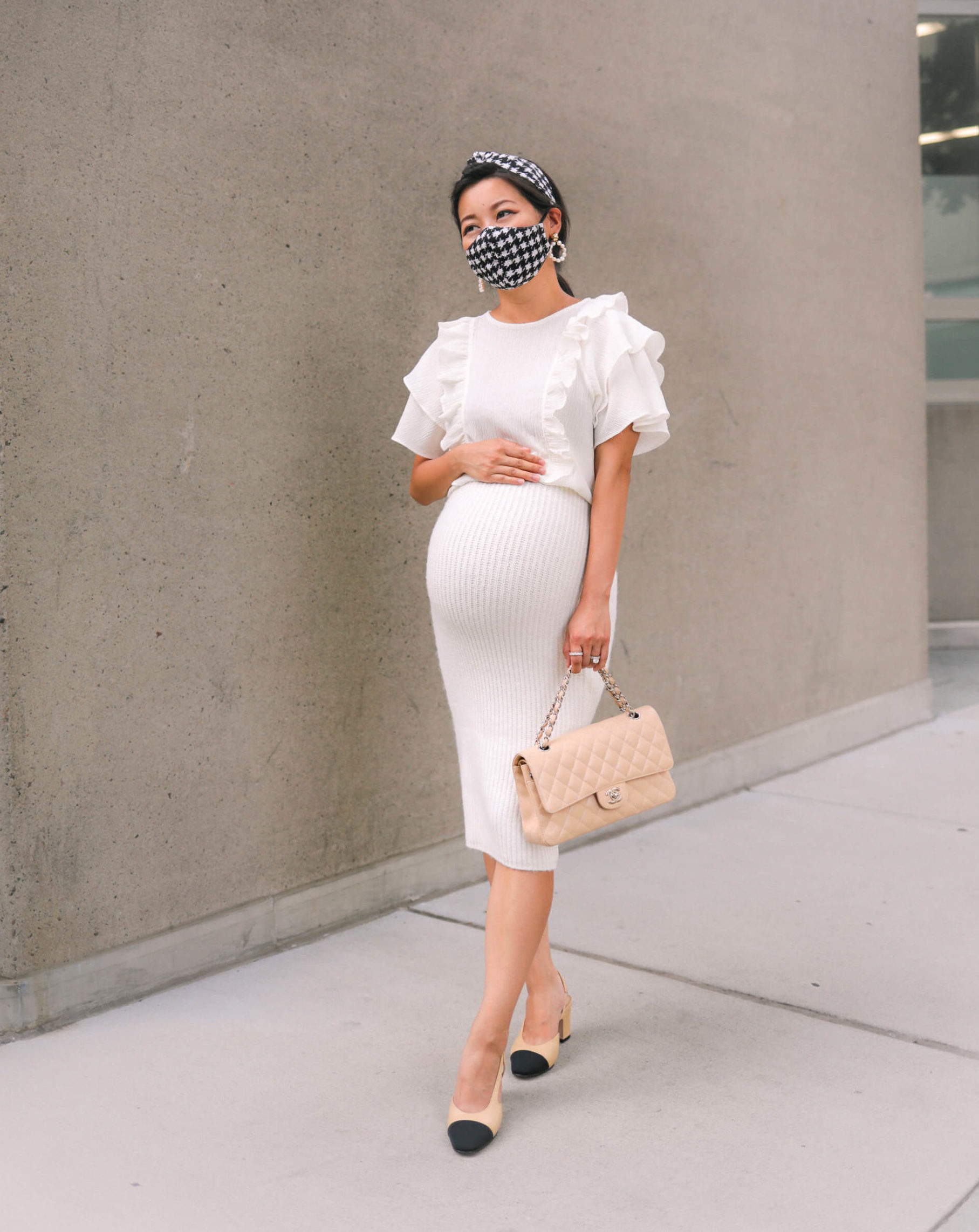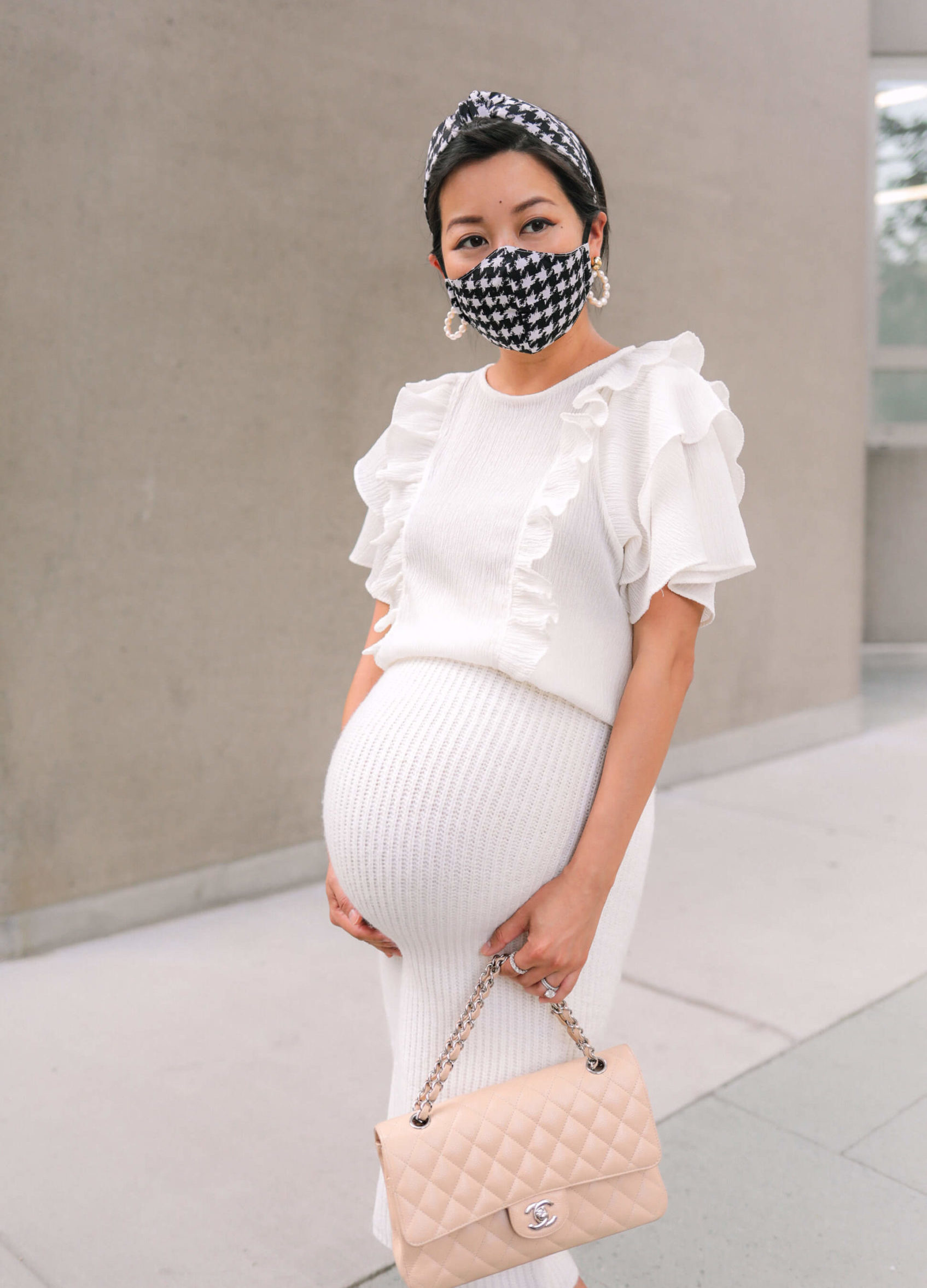
With my due date just 2 days away (eep!!), I realized I haven’t talked much about this pregnancy and wanted to answer some questions from the past few months! This post got long, so I’ve broken up the topics into a few sections!
Table of Contents
- Prenatals, skincare & maternity style
- Marriage & postpartum lessons learned
- Body image, pregnancy aches & staying fit
- Everything else, including petite friendly nursery chairs!
Here are a few related posts on these topics!
- 5 Practical Maternity Must Haves
- Maternity outfit ideas
- When Trying is Trying – on Infertility
- Nori’s Birth Story
- Hospital Bag + Postpartum Recovery Must Haves
- My Experience with Postpartum Depression
- Breastfeeding & Pumping: Tips that made a difference

1. Prenatals, skincare & maternity style
Q: Did you naturally conceive or do IVF again? If naturally, what did you do differently?
As shared in this post, this little one was naturally conceived. Similar to our first year of trying before Nori, I was tracking my ovulation cycles by using ovulation test strips (these are beginner friendly, while these are a much better value) and inspecting my cervical mucus (see 1st book recommendation below). Aside from much lower stress surrounding the TTC process, there isn’t anything tangible I can share that was different. While I’ve heard from many others since who also conceived naturally after IVF, everyone’s personal case and medical situation is so, so different.
Q: What pregnancy books did you read?
- Taking Charge of Your Fertility by Toni Weschler. An informative read if you want to better understand your body and fertility cycle, whether or not you’re trying to get pregnant.
- Expecting Better by Emily Oster. While I do not agree with everything in this book, I thought it was an interesting perspective nonetheless. Especially compared to those who caution against and limit SO much during pregnancy (i.e. many foods, drinks, activities and exercise), oftentimes based on outdated or non factual information.
Since this is a short list, I’d love to hear other interesting or useful reads covering TTC (trying to conceive), pregnancy, what to expect with first time parenting or newborn life! It Starts with the Egg by Rebecca Fett was a frequent recommendation for those who are TTC.
Q: What prenatal vitamins do you take?
I started a prenatal vitamin before TTC and will be taking one through postpartum and nursing. I found this article helpful for understanding what to look for in a good prenatal. Since many options don’t have all of the recommended levels of vitamins in one package, I’ve also been taking an iron and omega-3 supplement.
- Recently started Ritual’s Essential Prenatal which has come highly recommended by friends and specialists, and plan on taking these through postpartum.
- If gummies are easier for you to stomach, I had been taking Smarty Pants gummies after trying a whole bunch of gummy prenatals. Note: I’ve bought these from both Target & Amazon and the ones at Target seemed better quality / fresh. These don’t have calcium so make sure to get it elsewhere like ni your diet, and most gummy prenatals do not contain iron FYI.
- Iron supplements – I tested low for iron, which is essential later in pregnancy and can also correlate with chronic fatigue, which I was really feeling. After researching the types of iron and what is more easily absorbed by our bodies, I started taking grass fed beef liver capsules – I know this will sound gross and unusual to some, but I do think it has helped!
Q: What’s your skincare routine during pregnancy?
Moisturizers, serums, oils: I switch between a few depending on the climate and how my skin is feeling, but here’s some favorites that I’m comfortable with being pregnancy-safe after my own research:
- Everyday favorites: Elemis Pro-Collagen Marine Oil, or Peptide Night Recovery Cream Oil which has a unique texture that glides on easier than night cream for a super quick before bed product. And their facial cleansing balm is still my hands-down favorite that I like to apply in the shower, but Farmacy Green Clean balm is another good option and also pregnancy safe. I try to wait for an Elemis sale to get my haul!
- Squalane oils (love these!): Indie Lee squalane facial oil or Biossance (either regular or rose with vitamin C) at a better value. I apply these all over my face and neck on days when I just want a super quick hydration routine.
- Richer creams for dry skin: Tatcha dewy skin cream, Follain ultra hydrating mask which I use as a thicker night cream (you can use code JEANWANG 10% off at Follain)
For those interested in clean skincare in general, you can check out Follain’s restricted ingredients list for what they avoid in their products and why – I will say it’s much more stringent than what I follow personally, but interesting to read.
Vitamin C: As there’s a general consensus that retinol/retinoids are something to avoid while pregnant, I’ve been trying out Vitamin C serums, which are pregnancy-safe, have antioxidant and brightening properties, plus are supposed to help stimulate collagen production. Maelove Glow Maker is a reasonably priced option that came highly recommended by my skincare loving friends!
Sunscreen: I’ve personally continued to use Elta MD UV clear which is both a chemical and physical sunscreen mix, but I know some prefer to switch to a purely physical sunscreen. These generally tend to be thicker in consistency and leave more of a white cast. For physical sunscreens, I’ve been using Babo Organics on Nori including their Clear Zinc Sunscreen, and in this sunscreen post I reviewed their lighter weight Daily Sheer sunscreen for facial use.
Q: Tips for preventing stretch marks?
Most dermatologists and docs will tell you that stretch marks are primarily genetic based on your skin type, and partly situational to each pregnancy depending on how rapidly weight is gained in a certain area. So while creams and lotions can help keep your skin moisturized and less itchy as it stretches, I wouldn’t believe in “miracle” products.
See more of my thoughts below under body image, but with both pregnancies I’ve made sure to:
- Stay hydrated from the inside out with lots of water, which will be key during nursing as well! I keep this CamelBak water bottle on my desk and a second one on my bedroom nightstand, which has helped a lot with hydration reminders.
- Moisturize once or twice a day on the belly, chest, and thigh areas starting in the first trimester. I like just simple pure organic shea butter (which is thick, so you do have to warm it up in your hands before patting it on) or an easier to spread cream like Earth Mama Organics belly butter. You can also find pure organic shea butter on sites like Amazon for a lot less, but I haven’t personally tried any of those brands!
Q: Tips for morning sickness / nausea?
I was lucky to not experience much with either pregnancy, but below are some top tips shared by readers!
- Ginger hard candies or chews – your favorite brands were Chimes, Prince of Peace & Trader Joe’s!
- Vitamin B6 + Unisom
- Preggie Pop Drops
- Eating smaller, more frequent meals starting right when you wake up and having a snack like crackers or nuts in your bag at all times (since many of you said your nausea often correlated with low blood sugar or an empty stomach)
- Lemon water + smelling fresh lemons, fresh grated ginger “tea”
- Prescriptions like Zofran or Diclegis – of course, talk to your doc about the benefits vs. side effects
Q: What are some good stores for affordable maternity clothes?
For pregnancy outfit ideas utilizing both regular + maternity clothes, see all of my maternity outfits here!
- H&M Mama for affordable maternity basics and nursing pieces
- ASOS maternity for basics as well as more unique maternity pieces and dresses. I got a few more special occasion and maternity photoshoot dresses from here!
- Pink Blush Maternity which has a whole section on pieces that are petite-friendly, and helpful user reviews and photos.
- Amazon Maternity for easy free shipping and returns on lots of affordable bump-friendly dresses, maternity & undergarments and pajamas.
You really do not need much maternity-specific clothing. I got a good pair of maternity leggings (to wear with existing stretchy tops, tunics, sweaters), belly bands to wear with my regular pants & jeans unzipped, maternity undies, maternity support & smoothing shorts (my must-have), and a handful of maternity-specific everyday dresses for when I got bigger 2nd-3rd trimesters.
2. Marriage & Postpartum lessons learned
Q: Advice for first time moms on how to keep your marriage strong?
In advance of when baby arrives:
Discuss expectations with your partner and how you’ll share in the responsibilities. For example, how will you two be sharing middle of the night responsibilities? If you end up mainly breastfeeding and not doing bottles or formula, will your partner still wake up to help with diaper changes, burping, soothing a crying baby back to sleep? Who will take the early morning shift?
I’m not recommending making any concrete plans or schedules ahead of time, because newborn life will constantly be changing as you figure out your rhythm and adapt! But it’s good to at least start talking about this early on versus heated arguments while sleep deprived and emotional (which will likely still happen – and that’s totally normal).
Discuss signs of postpartum depression or anxiety with your partner before giving birth so they can be informed and help support you postpartum. After having Nori, I talked a little about my experience and things that helped me cope. Like many mamas, I could not recognize the signs in myself (or was dismissive of them) while deep in the fog, and it was my husband who suggested that I may be going through PPD.
Discuss the possibility of your partner taking extended paternity (or unpaid family) leave and how to financially plan for it. I know in many US workplaces, paternity leave is pretty much non-existent. I’m grateful Nick was able to take unpaid leave when I really needed the support, and in retrospect it should’ve been something we researched in advance and started financially planning for if needed.
Q: What did you learn your 1st pregnancy that you’ll do differently?
Prioritize postpartum care for the mother as much as care for the baby. Line up your postpartum support circle in advance. Accept help when it’s offered, and don’t be afraid to ask for help.
This could include:
- Talking to a parent or relative about coming to help for a bit postpartum, even if it’s something you’re not usually comfortable with asking.
- Joining a local new moms support group (or virtual one), or ask your doc or birthing hospital for suggestions on local lactation support groups.
- Looking into a hiring an overnight baby night nurse a few days a week if it’s in your budget, as they are often “reserved” by expectant families a few months in advance.
With Nori, my mom kindly offered to come help for a month (traditional Chinese postpartum care is focused on nurturing and replenishing the mother that first month), and I declined, wanting to figure things out ourselves and thinking our small condo would be too cramped. Boy did I change my mind the second time around!
Don’t be afraid to turn down visitors until you feel up for them.
Things are different now due to Covid (making it easier to politely decline visitors), but hosting well-intentioned family and friends can sometimes be the last thing you want to deal with postpartum while breastfeeding half naked and recovering down there. This “etiquette for visiting parents of a newborn” made the rounds on the internet, but I know for others, having visitors and seeing friends are a mood booster so do what’s right for you! After Nori was born, all our family came into town shortly afterwards, and this time it’ll just be my mom here for a month.
Instead of physically visiting, easy ways friends can support new mamas are by texting or calling to check in, dropping off food or baked goods, or sending an electronic food delivery gift card.
3. Body image, working out, pregnancy pains
Q: How do you deal with insecurities about your body changing?
Q: What workouts are you doing?
If your doc clears you for working out, I highly recommend setting aside a few times a week to work out through the end of your pregnancy. You do not need to be a fitness expert – even take just 20 minutes, 3x a week at home to do squats and lunges on repeat, which are great for beginners during pregnancy for strengthening & mobility. You can see short videos saved under my Instagram Stories here for examples of very simple lateral band steps, squats, and lunges while pregnant. All I bought for at home workouts was a mat, resistance bands, and these 5lb hand weights.
As another free option, I’ve done a bunch of prenatal workout videos on YouTube and enjoy BodyFit by Amy (easy to modify for beginners), this 6 minute workout which you can do on repeat, and this 30 minute pregnancy workout.
My first pregnancy, with the help of a personal trainer I stayed active leading up to giving birth and felt so good physically, mentally, and energy level-wise. After delivering Nori, my labor & delivery nurse and doc asked whether I had been working out, and commented on how that may have contributed to a smooth and short labor. This pregnancy, my workouts fell to the wayside and I am for sure feeling the difference!
Q: What helped with your sciatica or pregnancy back pain?
- Regular stretches throughout the day geared toward sciatica. I looked up a bunch on Youtube and ended up doing the simple cat / cow stretch multiple times a day, including when I got out of bed. If the pain is very intense or chronic though, definitely talk to your OB about seeing a chiropractor or specialist.
- Strengthen your lower body. I actually started personal training sessions my first pregnancy due to bad sciatica pains. My trainer geared a lot of our workouts toward lower body / hip / pelvic area strengthening and mobility, which beginners can do easily at home with daily squats and lunges in various directions!
- Wear supportive bottoms. I rotate between these maternity support shorts and Zella maternity leggings almost daily and feel an instant lift and relief when I put them on. If you need something even more supportive, I had a support belt from Amazon my first pregnancy but its more bulky under clothing.
- Support while sleeping. I love my Boppy pillow (also at Target) from my maternity must haves post – note this is a fluffier, less firm and less filled pillow which I personally liked for knee and belly support to help keep my back better aligned while side sleeping.
4. Everything else!
Q: Petite friendly nursery / glider chair recommendations?
Q: How do you cope with anxiety between each OB visit?
With Nori, I got a baby heartbeat doppler to listen to at home which we still enjoy using, BUT I’m not exactly recommending this because you might end up causing yourself even more anxiety. When you’re not a doctor or expert, it can be hard to locate the heartbeat and then freak out even though baby is totally fine. Nick became an expert at finding the heartbeat but I almost never could!
Q: What are you packing in your hospital bag?
After having Nori I shared all the details on My Hospital Bag and Postpartum Must Haves, and for baby #2 I’ve literally packed almost the exact same stuff. Remember, most birthing hospitals will provide your postpartum care & healing necessities, although they will be generic versions and some of the FridaMom brand ones may be worth the upgrade.
To wear home, this time I now know to bring something nursing-friendly, comfortable and loose (and dark colored, if you’re concerned about getting blood on your clothes) as you might still look or feel 7 months pregnant right after giving birth, so I’d leave your pre-pregnancy jeans at home!
Q: Have you worked with a doula?
I researched local doulas my first pregnancy, but my OB’s advice was that they may be more helpful if you’re planning to have an unmedicated birth, and less so with an epidural. I know everyones opinion on this will be different, but having had an epidural with Nori, I would definitely agree that I would personally not have benefitted from another person in the room. However, this could also be due to my birthing hospital experience, where my labor & delivery nurse was wonderful from start to finish in making me feel comfortable, coaching me, letting me know what to expect and when to push.
Q: Biggest differences between each pregnancy?
The fatigue is real while pregnant with a toddler! To get me through the day my 1st trimester, I would do a quick at home workout during Nori’s naptime. I dreaded it, but it always helped boost my energy for the afternoon. As mentioned above, one of my biggest regrets is letting those workouts slip.
Body-wise, much of what they say was true for me…second time around, my belly popped much earlier (since your uterus has been stretched out before) and got a lot bigger more quickly. I’ve had lots of Braxton Hicks “practice contractions” starting earlier in my second trimester, and a more low hanging belly.
With Covid protocols, this time Nick was unable to attend the ultrasounds. I’m grateful he got to experience them with Nori, and can’t imagine how this might feel for first time mamas who are pregnant this year!
Q: How many kids do you want?
Two! Feeling very grateful for where we’re at, and also bittersweet that this is most likely my last pregnancy. Each pregnancy around this time, despite discomforts, I become very emotional as this very intimate bond of growing a little one inside comes to an end.
Q: How are you preparing Nori for the transition?
Been working on a blog post with some wonderful tips we’ve received and will be trying to do – stay tuned!
Related Posts
- 5 Practical Maternity Must Haves
- Lots of Maternity outfit ideas
- When Trying is Trying – on Infertility and IVF
- My Childbirth Story with Nori
- My Hospital Bag + Postpartum Recovery Must Haves
- My Experience with Postpartum Depression
- Breastfeeding & Pumping: Tips that made a difference




